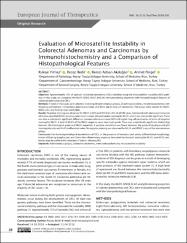| dc.contributor.author | Yılmaz, Rukiye | |
| dc.contributor.author | Bedir, Recep | |
| dc.contributor.author | Akdoğan, Remzi Adnan | |
| dc.contributor.author | Pergel, Ahmet | |
| dc.date.accessioned | 2020-12-19T20:42:29Z | |
| dc.date.available | 2020-12-19T20:42:29Z | |
| dc.date.issued | 2019 | |
| dc.identifier.citation | yılmaz, R., Bedir, R., Akdoğan, RA., Pergel, A. (2019). Evaluation of microsatellite instability in colorectal adenomas and carcinomas by immunohistochemistry and a comparison of histopathological features. European Journal of Therapeutics, 25(1), 28-38. | en_US |
| dc.identifier.issn | 2564-7784 | |
| dc.identifier.issn | 2564-7040 | |
| dc.identifier.uri | https://doi.org/10.5152/EurJTher.2018.582 | |
| dc.identifier.uri | https://app.trdizin.gov.tr/makale/TXpnd01qZ3lNZz09 | |
| dc.identifier.uri | https://hdl.handle.net/11436/5727 | |
| dc.description.abstract | Objective: Approximately 15% of sporadic colorectal carcinomas (CRCs) develop along the microsatellite instability (MSI) pathway. In this study, we compared the MLH1, MSH2, Ki-67, and p53 immunostaining properties with histopathological features of colorectal adenomas and CRCs. Methods: A total of 102 cases were selected, including 50 adenomatous polyps, 25 adenocarcinomas, 10 adenocarcinomas with mucinous component, 14 mucinous adenocarcinomas, and three signet-ring cell carcinomas. The tissues were stained for MLH1, MSH2, p53, and Ki-67 primary antibodies. Results: Negative staining was observed for MLH1 in 25% and MSH2 in 3.8% of all CRC cases. Compared with adenocarcinoma not otherwise specified (NOS), mucinous adenocarcinomas showed weaker staining for MLH1, which was statistically significant. There was also a statistically significant difference between adenocarcinoma NOS and signet-ring cell carcinomas in terms of negative staining for MLH1. A total of 69.2% of the MLH1-negative cases were high-grade. There was a statistically significant relationship between the histological grade and MLH1 negativity. A positive correlation was found between the grade of dysplasia and p53 staining intensity and Ki-67 proliferation index. No negative staining was observed for MLH1 and MSH2 in any of the adenomatous polyps. Conclusion: For the histopathological examination of CRCs, in the presence of mucinous and poorly differentiated morphology, tumor-infiltrating lymphocytes and Crohn-like inflammatory response, immunohistochemical staining for MLH1, and MSH2 antibodies may be useful in the detection of tumors showing MSI. | en_US |
| dc.language.iso | eng | en_US |
| dc.publisher | AVES | en_US |
| dc.rights | info:eu-repo/semantics/openAccess | en_US |
| dc.subject | Adenomatöz Polipler | en_US |
| dc.subject | Kolorektal Karsinomlar | en_US |
| dc.subject | İmmünohistokimya | en_US |
| dc.subject | Mikro Uydu Kararsızlığı | en_US |
| dc.title | Evaluation of microsatellite instability in colorectal adenomas and carcinomas by immunohistochemistry and a comparison of histopathological features | en_US |
| dc.type | article | en_US |
| dc.contributor.department | RTEÜ, Tıp Fakültesi, Dahili Tıp Bilimleri Bölümü | en_US |
| dc.identifier.doi | 10.5152/EurJTher.2018.582 | |
| dc.identifier.volume | 25 | en_US |
| dc.identifier.issue | 1 | en_US |
| dc.identifier.startpage | 28 | en_US |
| dc.identifier.endpage | 38 | en_US |
| dc.ri.edit | oa | en_US |
| dc.relation.journal | European Journal of Therapeutics | en_US |
| dc.relation.publicationcategory | Makale - Uluslararası Hakemli Dergi - Kurum Öğretim Elemanı | en_US |


















